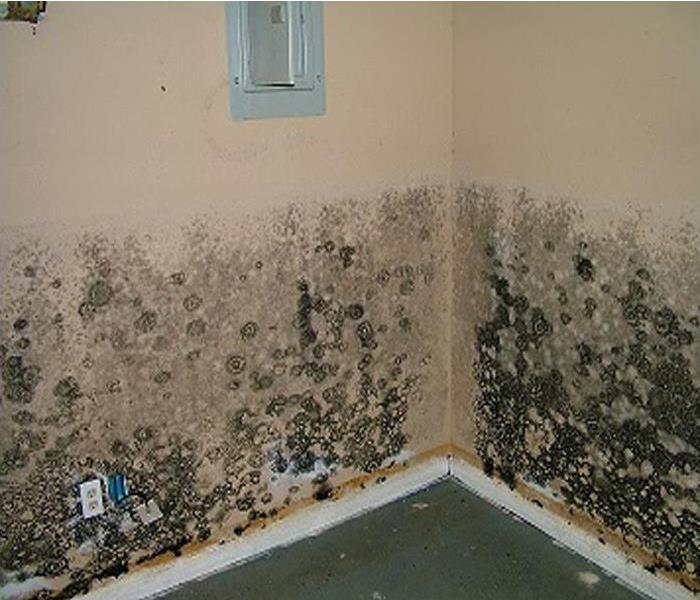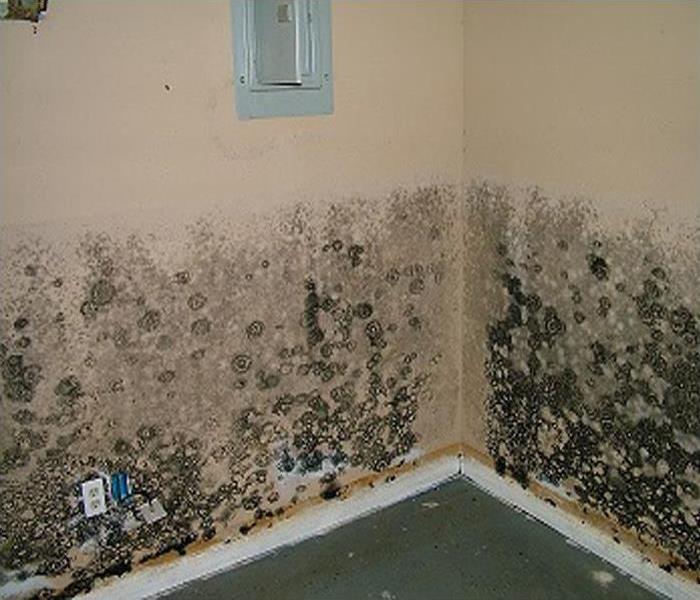Recent Mold Remediation Posts
Mold
9/3/2019 (Permalink)
Mold is a microscopic organism commonly found both indoors and outdoors. Mold, along with mushrooms and yeast, are known scientifically as fungi. Their purpose in nature is to break down dead material and recycle nutrients in the environment. For mold to grow and reproduce, they need a food source - any organic material, such as leaves, wood, paper, or dirt - and moisture. Since mold grows by "eating" the organic material, they gradually destroy whatever they are feeding on.
Mold growth on surfaces can often be seen as a colored spot, frequently green, gray, brown, black or white. It commonly appears as a powdery, fuzzy, or hair-like material. Actively growing mold typically produce odors, sometimes described as earthy or moldy, or like mildew, old dirty socks, or ammonia. Molds release thousands of microscopic spores, which are lightweight, easily airborne and carried by air currents to surrounding areas. The spores must have both food and moisture to actually start growing, similar to plant seeds.
If you think you may have a mold issue in your home or business call, SERVPRO of Paris 903-784-2700
Mold is not Always Easy to Spot
2/11/2019 (Permalink)
One of the most common problems that homeowners face are mold and mildew infestations. This fungus grows on anything and thrives anywhere it can find moisture, especially places that are damp, warm, poorly lit, and poorly ventilated. Not only does it produce a musty, unpleasant odor, but when left unchecked it can cause serious damage.
Mold is not limited to growing in obvious places, it can grow and thrive in the dark corners of your home. These leaks can be small and hard to notice especially when they are behind walls.
Mold can spread throughout a property in as little as 48 hours. If you suspect you have mold in your home, you should call us to inspect your home. If mold is found, we have the training, equipment, and expertise to remediate your mold infestation. Call us at 903-784-2700
What Exactly Is Mold?
6/6/2018 (Permalink)
Mold can be found almost anywhere; they can grow on virtually any organic substance, as long as moisture and oxygen are present. There are molds that can grow on wood, paper, carpet, foods, and insulation. Molds reproduce by making spores that usually cannot be seen without magnification. Mold spores waft through the indoor and outdoor air continually. When mold spores land on a damp spot indoors, they may begin growing and digesting whatever they are growing on in order to survive. Molds gradually destroy the things they grow on. Bacteria can start to grow within hours and mold can start to grow within days. Mold spores can lay dormant for years until an ideal growing condition develops, in which they start to flourish. Especially during the summer, the warm humid conditions are a perfect microenvironment for mold growth.
When excessive moisture accumulates in buildings or on building materials, mold growth will often occur—particularly if the moisture problem remains undiscovered or unaddressed. It is impossible to eliminate all molds and mold spores in an indoor environment. However, mold growth can be controlled indoors by controlling the moisture. Many types of molds exist. All molds have the potential to cause serious health effects. Molds can produce allergens that can trigger allergic reactions or even asthma attacks in people allergic to it. Others are known to produce potent toxins and/or irritants. Potential health concerns are an important reason to prevent mold growth and to remediate and clean any existing mold growth indoors. The purpose of mold remediation is to remove the mold to prevent human exposure and damage to building materials and furnishings. It is necessary to clean up mold contamination, not just kill it. Dead mold is still allergenic, and some dead molds are still potentially toxic! Applying the appropriate restoration procedures within the first few hours of a water loss can save thousands of dollars in secondary damage.
Before the growth of mold becomes visible, there will be a faint musty or earthy smell. In time, mold will appear on the outside of the wall as a stain or discoloration. In a standard situation, SERVPRO of Paris will examine the structure for any visible signs of mold and remove the mold growth and excess spores returning the area back to normal levels. Some situations require the assistance of an Indoor Air Quality/Environmental Professional (IEP) with specialized equipment and services needed to assess and/or repair the structure. IEPs can test and clear a structure for mold by collecting air and surface samples. Then they can determine whether the mold has been successfully decontaminated. We encourage you to call us today if you suspect a mold problem in your home or business. We handle mold remediation work on a daily basis and know when prompt action is required to prevent further mold growth. SERVPRO of Paris technicians are trained to control microbial problems in structures by promptly drying wet or damp materials according to the Institute of Inspection Cleaning and Restoration Certification (IICRC) standards and removing or replacing wet or damp porous materials, like drywall, that have visible mold growth. Call today for an immediate response. We are here to make it “Like it never even happened.”
Mold Can Be Tricky To Spot!
6/6/2018 (Permalink)
One of the most common problems that homeowners face are mold and mildew infestations. This fungus grows on anything and thrives anywhere it can find moisture, especially places that are damp, warm, poorly lit, and poorly ventilated. Not only does it produce a musty, unpleasant odor, but when left unchecked it can cause serious damage.
Mold is not limited to growing in obvious places, it can grow and thrive in the dark corners of your home. In one home, mold was growing because of a leak in their ice-maker water line. These leaks can be small and hard to notice especially when they are behind walls.
Mold can spread throughout a property in as little as 48 hours. If you suspect you have mold in your home, you should call us to inspect your home. If mold is found, we have the training, equipment, and expertise to remediate your mold infestation.
The Process of Mold Remediation
5/24/2018 (Permalink)
Nobody wants to hear the word mold. Since our youth we have been taught mold is bad and harmful to your health. If you have mold on your food you throw it away. If mold is in the air you pray for rain and head to the drug store for sinuses medicine. If mold is involved there is a problem, especially if it is in your house. But, luckily for everyone mold can be remediated. People forget there are mold spores all around us outside all the time. The purpose of a house is to protect you from the outside elements like keeping mold spores in nature. Some individuals are more sensitive to allergies than others. Good thing mold remediation is a common practice and can be done in a timely manner with some simple steps.
First and foremost, the moisture source of the mold growth must be eliminated or fixed before cleaning can begin. If you notice a water leak, please contact a plumber immediately.
Mold remediation can simplified into three steps:
- Control Environment-Set up containment, air filtration equipment and negative air flow to control environment and prevent further contamination.
- Remove and Clean- Remove and properly dispose of all porous materials contaminated with mold. Clean all nonporous materials contaminated with mold, HEPA vacuum, and apply anti-microbial agent.
- Dry Structure- Dry structure to reduce moisture levels below that which enables growth. Obtain final clearance testing from Indoor Environmental Professional (IEP).
SERVPRO of Paris specializes in mold remediation for both commercial and residential buildings. If you notice mold growing in your home or business, please give us a call today at 903-784-2700.
Mold Remediation
5/23/2018 (Permalink)
Mold is a fungus, and it grows virtually everywhere on Earth. Lately, mold has become a hot topic because of increasing awareness about its potential health hazards. People aren’t exactly sure how many mold species there are, but estimates range anywhere between tens of thousands to over a few hundred thousand. Some of these different types aren’t dangerous to human health, while others lead to chronic and severe health conditions.
From: Aer Industries Article
In as little as 48 hours, a minor mold issue can quickly spread through a home or business. Once you contact us, we’re dedicated to starting the remediation process quickly. This fast response lessens the mold damage, limits additional damage, and reduces the remediation cost.
Ward Off Prospective Mold Troubles
5/21/2018 (Permalink)
You can take practical steps to foster mold prevention in your unoccupied building. Be familiar with your building's materials, keep surfaces free of debris and make reasonable improvements to substandard fixtures. Turn off the water to avert any surprises from leaky pipes. Keep the heat down, but not all the way off if you can avoid it. The aim is to maintain low humidity by cultivating a cool, dry environment. Some air movement can actually help in this regard and can dry up existing condensation. These steps can take you a long way toward curtailing future mold issues. If you have any problems, call on professionals who can help.
If You See Signs of Mold, Call Us Today – 903-784-2700
Know What Makes Mold Grow?
5/21/2018 (Permalink)
There are three components conducive to the flourishing of mold spores. 1. Moisture 2. A food source 3. Warmth Generally, moisture is the most important condition for mold growth, and may arise from many sources. Water pipes or roofs may harbor leaks. Condensation can intensify in areas with poor ventilation or insulation, such as basements. Humid climates naturally generate dampness, which can seep into the structure and aggravate preexisting problems. A disaster such as a flood may cause serious water damage, after which immediate mold prevention measures should be taken by a mold remediation specialist. While mold growth begins with moisture, a steady source of food can really make it mushroom. Unfortunately, such sources are usually readily available in common building materials such as wood, drywall and carpeting. All these contain cellulose, which comes from plant cells and is rich in the nutrients mold needs. Additional food sources include dust and other organic substances. Mold thrives particularly well in hot, humid places. There's a direct relationship between moisture and air temperature. The higher the temperature, the more moisture the air can hold.
Does Homeowners Insurance Cover Mold?
5/11/2018 (Permalink)
Homeowners insurance does not usually cover mold damages. Although, there are instances when mold is covered. These instances are generally when the cause of mold is due to an incident that homeowners insurance does cover. For example, if mold has grown due to accidental and sudden pipe burst or if a recent fire has caused mold, your homeowners insurance will likely cover the mold damages. On the contrary, if mold has grown due to improper maintenance practices, such as on-going humidity exposure or a continuous leak, homeowners insurance will not likely cover the damages.
If you believe you may have a mold issue give us a call today to have one of our experienced technicians come out and access your concerns!! SERVPRO of Paris 903-784-2700
Mold Removal vs Mold Remediation
1/26/2018 (Permalink)
What’s the Difference?
Since microscopic mold spores exist naturally almost everywhere, indoors and outdoors, removing all mold from a home or business is impossible. Many restoration businesses advertise “mold removal” and even guarantee to remove all mold. This is a fallacy. We understand mold and mold growth.
Understanding Mold
When water intrudes into your property, mold growth can start in as little as 48 hours. Consider the following mold facts:
- Mold is present almost everywhere, indoors and outdoors.
- Mold spores are microscopic, float along in the air, and may enter your home through windows, doors, or AC/heating systems or even hitch a ride indoors on your clothing or a pet.
- Mold spores thrive on moisture. Mold spores can quickly grow into colonies when exposed to water. These colonies may produce allergens and irritants.
- Before mold remediation can begin, any sources of water or moisture must be addressed. Otherwise, the mold may return.
- Mold often produces a strong, musty odor, and that odor can lead you to possible mold problem areas.
- Even higher-than-normal indoor humidity can support mold growth. Keep indoor humidity below 45 percent.
Get Rid of Mold
8/28/2017 (Permalink)
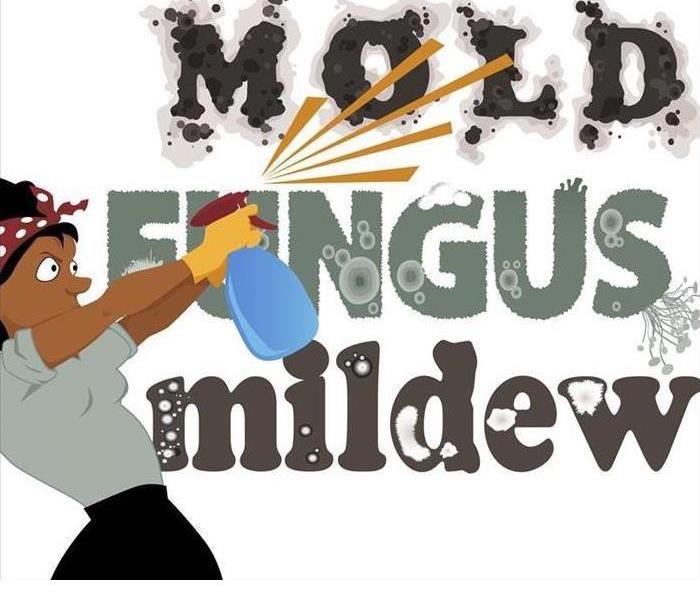 It looks like this lady is getting rid of some pretty tough issues.....
It looks like this lady is getting rid of some pretty tough issues.....
Here are some healthy tips to follow when you are dealing with mold. Some people cringe at the sound of the word mold but it may be easier to take care of then you think. Hopefully these will help ease the stress along the way.
- Take things that were wet for 2 or more days outside. Things that stay wet 2 or more days can have mold on them. Mold is not always visible by looking.
- Take out stuff made of cloth, unless you can wash them in HOT water.
- Use bleach to clean mold of of hard things(like floors, counter tops, toys, tools, and plates.)
- Never mix bleach with ammonia or other cleaners.
- wear rubber boots, rubber gloves, googles, and a mask.
- Open windows and doors to get fresh air when you use bleach.
- Mix no more than 1 cup of bleach in 1 gallon of water.
- Wash the item with the bleach and water mixture.
- Rinse the item with clean water.
- Dry the item or leave it out to dry.
Mold Prevention Tips
6/15/2017 (Permalink)
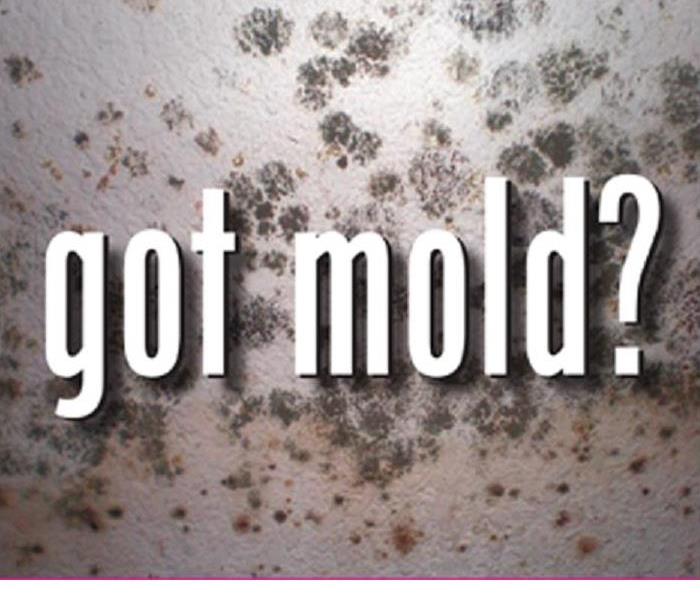 Check around the house and make sure you don't have mold.
Check around the house and make sure you don't have mold.
Nobody likes a mold problem. There are several ways to prevent mold growth in your home. Here are some tips to help you get started.
- Control your indoor climate
- Keep a eye out for standing water
- Do not leave wet clothing around for more then two days.
- If the moisture becomes to much in your home, add a dehumidifier.
- Check for drainage problems around the home.
- Eliminate clutter in and outside of the home
- Properly size your air conditioner unit to the size of your home.
- An indoor humidity monitor will help you keep track of the moisture in your home
- Always check your air conditioning unit before turning it on for the season.
- Call a professional if you believe you may have any mold problem.
Good Mold VS. Bad Mold
4/26/2017 (Permalink)
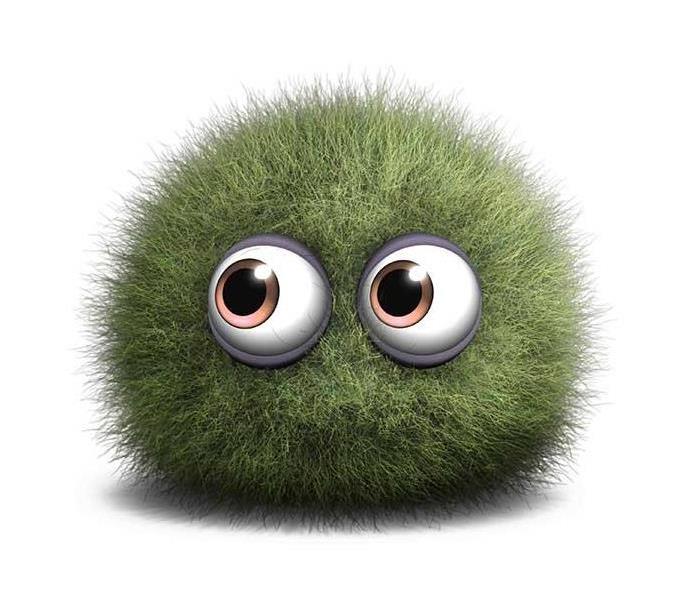
When most of us hear the word mold we assume it could be good mold or bad mold. Let's take good mold for example. It is found in medicines to cure illness. It is also found in cheeses and of course the moldy loaf of bread left open a little to long. Next we have a type of normal mold that falls in between good and bad. There are two types of normal molds. There are airborne mold spores and mold growth. There is simply no way around the airborne mold. This type of mold is present to some degree in the air we breath. The mold we see in our homes such as in the window seals and bathtubs are simply common day to day molds. They are not from a sustainable food source. It can be cleaned away, so this makes it normal. The bad mold people fear most is considered bad mold because it could potentially affect the air with elevated mold spores which is quite a bit different than normal.The food sources within a home are pretty numerous. Materials must be properly removed and/or cleaned. Airborne issues must also be addressed. The first step a homeowner should take if they suspect mold is to call a specialist to ensure the proper precautions and testing are done properly.






 24/7 Emergency Service
24/7 Emergency Service
